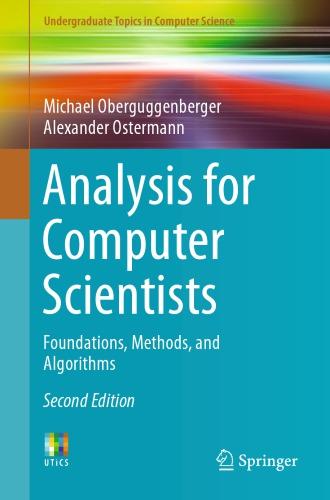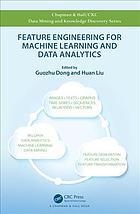HPLC and Uhplc for Practicing Scientists Michael W. Dong
Visit to download the full and correct content document: https://textbookfull.com/product/hplc-and-uhplc-for-practicing-scientists-michael-w-do ng/

More products digital (pdf, epub, mobi) instant download maybe you interests ...

Commercialization secrets for scientists and engineers
1st Edition Michael Szycher
https://textbookfull.com/product/commercialization-secrets-forscientists-and-engineers-1st-edition-michael-szycher/

Analysis for Computer Scientists Foundations Methods and Algorithms Michael Oberguggenberger
https://textbookfull.com/product/analysis-for-computerscientists-foundations-methods-and-algorithms-michaeloberguggenberger/

Probability and statistics for computer scientists
Third Edition Michael Baron
https://textbookfull.com/product/probability-and-statistics-forcomputer-scientists-third-edition-michael-baron/

Difference Equations For Scientists And Engineering
Interdisciplinary Difference Equations 1st Edition
Michael A. Radin
https://textbookfull.com/product/difference-equations-forscientists-and-engineering-interdisciplinary-differenceequations-1st-edition-michael-a-radin/

Creating Digital Faces for Law Enforcement Michael W. Streed (Auth.)
https://textbookfull.com/product/creating-digital-faces-for-lawenforcement-michael-w-streed-auth/

International Bureaucracy: Challenges and Lessons for Public Administration Research 1st Edition Michael W. Bauer
https://textbookfull.com/product/international-bureaucracychallenges-and-lessons-for-public-administration-research-1stedition-michael-w-bauer/

Feature Engineering for Machine Learning and Data Analytics First Edition Dong
https://textbookfull.com/product/feature-engineering-for-machinelearning-and-data-analytics-first-edition-dong/

Aptamers for Analytical Applications Affinity Acquisition and Method Design Yiyang Dong
https://textbookfull.com/product/aptamers-for-analyticalapplications-affinity-acquisition-and-method-design-yiyang-dong/

Simply Psychology 4th Edition Michael W. Eysenck
https://textbookfull.com/product/simply-psychology-4th-editionmichael-w-eysenck/
HPLCANDUHPLCFOR PRACTICINGSCIENTISTS
SecondEdition
Thiseditionfirstpublished2019
©2019JohnWiley&Sons,Inc.
“JohnWiley&Sons,Inc.(1e,2006)”
Allrightsreserved.Nopartofthispublicationmaybereproduced,storedinaretrievalsystem,ortransmitted,in anyformorbyanymeans,electronic,mechanical,photocopying,recordingorotherwise,exceptaspermittedby law.Adviceonhowtoobtainpermissiontoreusematerialfromthistitleisavailableat http://www.wiley.com/go/ permissions.
TherightofMichaelW.Dongtobeidentifiedastheauthorofthisworkhasbeenassertedinaccordancewithlaw.
RegisteredOffice
JohnWiley&Sons,Inc.,111RiverStreet,Hoboken,NJ07030,USA
EditorialOffice
111RiverStreet,Hoboken,NJ07030,USA
Fordetailsofourglobaleditorialoffices,customerservices,andmoreinformationaboutWileyproductsvisitusat www.wiley.com
Wileyalsopublishesitsbooksinavarietyofelectronicformatsandbyprint-on-demand.Somecontentthat appearsinstandardprintversionsofthisbookmaynotbeavailableinotherformats.
LimitofLiability/DisclaimerofWarranty
Inviewofongoingresearch,equipmentmodifications,changesingovernmentalregulations,andtheconstantflow ofinformationrelatingtotheuseofexperimentalreagents,equipment,anddevices,thereaderisurgedtoreview andevaluatetheinformationprovidedinthepackageinsertorinstructionsforeachchemical,pieceofequipment, reagent,ordevicefor,amongotherthings,anychangesintheinstructionsorindicationofusageandforadded warningsandprecautions.Whilethepublisherandauthorshaveusedtheirbesteffortsinpreparingthiswork,they makenorepresentationsorwarrantieswithrespecttotheaccuracyorcompletenessofthecontentsofthiswork andspecificallydisclaimallwarranties,includingwithoutlimitationanyimpliedwarrantiesofmerchantabilityor fitnessforaparticularpurpose.Nowarrantymaybecreatedorextendedbysalesrepresentatives,writtensales materialsorpromotionalstatementsforthiswork.Thefactthatanorganization,website,orproductisreferredto inthisworkasacitationand/orpotentialsourceoffurtherinformationdoesnotmeanthatthepublisherand authorsendorsetheinformationorservicestheorganization,website,orproductmayprovideor recommendationsitmaymake.Thisworkissoldwiththeunderstandingthatthepublisherisnotengagedin renderingprofessionalservices.Theadviceandstrategiescontainedhereinmaynotbesuitableforyoursituation. Youshouldconsultwithaspecialistwhereappropriate.Further,readersshouldbeawarethatwebsiteslistedinthis workmayhavechangedordisappearedbetweenwhenthisworkwaswrittenandwhenitisread.Neitherthe publishernorauthorsshallbeliableforanylossofprofitoranyothercommercialdamages,includingbutnot limitedtospecial,incidental,consequential,orotherdamages.
LibraryofCongressCataloging-in-PublicationData
Names:Dong,M.W.,author.
Title:HPLCandUHPLCforpracticingscientists,secondedition/MichaelW.Dong. Othertitles:ModernHPLCforpracticingscientists
Description:Secondedition.|Hoboken,NJ:Wiley,2019.|Originally published:ModernHPLCforpracticingscientists.2006.|Includes bibliographicalreferencesandindex.|
Identifiers:LCCN2019002892(print)|LCCN2019003814(ebook)|ISBN 9781119313793(AdobePDF)|ISBN9781119313779(ePub)|ISBN9781119313762 (paperback)
Subjects:LCSH:Highperformanceliquidchromatography.|Drugs–Analysis.| BISAC:SCIENCE/Chemistry/Analytic.
Classification:LCCRS189.5.H54(ebook)|LCCRS189.5.H54D662019(print)| DDC615.1/901–dc23
LCrecordavailableathttps://lccn.loc.gov/2019002892
CoverDesign:Wiley
CoverImages:CourtesyofMichaelW.Dong;Background:©Wasant/Shutterstock Setin10/12ptTimesTenLTStdbySPiGlobal,Chennai,India
PrintedinUnitedStatesofAmerica
10987654321
Author’sBiographyxvii
BiographiesofContributorsxix
Preface xxi
Foreword xxiii
Acknowledgmentsxxv
1Introduction1
1.1Introduction / 1
1.1.1Scope / 1
1.1.2WhatIsHPLC? / 2
1.1.3ABriefHistory / 3
1.1.4AdvantagesandLimitations / 4
1.1.5Ultra-High-PressureLiquidChromatography(UHPLC) / 4
1.2PrimaryModesofHPLC / 4
1.2.1Normal-PhaseChromatography(NPC) / 5
1.2.2Reversed-PhaseChromatography(RPC) / 5
1.2.3Ion-ExchangeChromatography(IEC) / 6
1.2.4Size-ExclusionChromatography(SEC) / 8
1.2.5OtherSeparationModes / 8
1.3SomeCommon-SenseCorollaries / 10
1.4HowtoGetMoreInformation / 11
1.5Summary / 11
1.6Quizzes / 11
1.6.1BonusQuiz / 12 References / 12
2BasicTermsandConcepts15
2.1Scope / 15
2.2BasicTermsandConcepts / 16
2.2.1RetentionTime(tR ),VoidTime(tM ),PeakHeight(h),andPeak Width(wb ) / 16
2.2.2RetentionVolume(VR ),VoidVolume(VM ),andPeakVolume / 16
2.2.3RetentionFactor(k) / 18
2.2.4SeparationFactor(�� ) / 19
2.2.5ColumnEfficiencyandPlateNumber(N) / 20
2.2.6PeakVolume / 20
2.2.7HeightEquivalenttoaTheoreticalPlateorPlateHeight(HETP or H) / 21
2.2.8Resolution(Rs ) / 21
2.2.9PeakSymmetry:AsymmetryFactor(As )andTailingFactor(Tf ) / 23
2.3MobilePhase / 24
2.3.1GeneralRequirements / 24
2.3.2SolventStrengthandSelectivity / 25
2.3.3pHModifiersandBuffers / 27
2.3.4AcidicMobilePhases / 28
2.3.5Ion-PairingReagentsandChaotropicAgents / 29
2.3.6High-pHMobilePhases / 29
2.3.7OtherOperatingParameters:FlowRate(F)andColumn Temperature(T) / 30
2.4TheResolutionEquation / 31
2.5TheVanDeemterEquation / 33
2.6Isocraticvs.GradientAnalysis / 35
2.6.1PeakCapacity(n) / 35
2.6.2GradientParameters(InitialandFinalSolventStrength,Gradient Time(tG ),andFlowRate) / 36
2.6.3The0.25 ΔtG Rule:WhenIsIsocraticAnalysisMore Appropriate? / 37
2.7TheConceptofOrthogonalityandSelectivityTuning / 38
2.8SampleCapacity / 41
2.9GlossaryofHPLCTerms / 41
2.10SummaryandConclusion / 42
2.11Quizzes / 42
2.11.1BonusQuiz / 44 References / 44
3HPLCColumnsandTrends45
3.1Scope / 45
3.1.1GlossaryandAbbreviations / 45
3.2GeneralColumnDescriptionandCharacteristics / 46
3.2.1ColumnHardware–Standardvs.CartridgeFormat / 47
3.3ColumnType / 47
3.3.1TypesBasedonChromatographicMode / 48
3.3.2ColumnTypesBasedonDimension / 48
3.3.3ColumnLength(L) / 48
3.4ColumnPackingCharacteristics / 50
3.4.1SupportType / 50
3.4.2ParticleSize(dp ) / 51
3.4.3SurfaceAreaandPoreSize(dpore ) / 51
3.4.4BondingChemistries / 52
3.5ModernHPLCColumnTrends / 54
3.5.1SilicaSupportMaterial / 54
3.5.2HybridParticles / 55
3.5.3NovelBondingChemistries / 58
3.5.3.1BondedPhasesforRetentionofPolarAnalytes / 59
3.5.3.2ChargedSurfaceHybrid(CSH) / 61
3.5.4ShorterandNarrowerColumnsPackedwithSmallParticles / 61
3.5.4.1FastLC / 61
3.5.4.2UHPLC / 62
3.5.5Micro-LCandNano-LC / 62
3.5.6Monoliths / 64
3.5.7SuperficiallyPorousParticles(SPP) / 65
3.5.7.1KineticPlotsDemonstratingtheSuperiorityofSPP / 66
3.5.8MicropillarArrayChromatography(μPAC) / 67
3.6GuardColumns / 69
3.7SpecialtyColumns / 69
3.7.1BioseparationsColumns / 69
3.7.2ChiralColumns / 69
3.7.3SupercriticalFluidChromatography(SFC)Columns / 71
3.7.4HydrophilicInteractionLiquidChromatography(HILIC) Columns / 72
3.7.5Mixed-ModeChromatography(MMC)Columns / 72
3.7.6Application-SpecificColumns / 73
3.8RPCColumnSelectionGuides / 73
3.8.1SomeGeneralGuidelinesforBondedPhaseSelection / 75
3.9Summary / 76
3.10Quizzes / 76
3.10.1BonusQuiz / 78 References / 78
4HPLC/UHPLCInstrumentationandTrends81
4.1Introduction / 81
4.1.1Scope / 81
4.1.2HPLCSystemsandModules / 81
4.1.3Ultra-High-PressureLiquidChromatography(UHPLC) / 83
4.2HPLCandUHPLCSolventDeliverySystems / 83
4.2.1High-PressureandLow-PressureMixingDesignsinMultisolvent Pumps / 85
4.2.2SystemDwellVolume / 86
4.2.2.1DwellVolumesofUHPLCSystems / 87
4.2.3Trends / 88
4.3InjectorsandAutosamplers / 88
4.3.1OperatingPrinciplesofAutosamplers / 88
4.3.2PerformanceCharacteristicsandTrends / 89
4.4Detectors / 91
4.5UV/VISAbsorbanceDetectors / 92
4.5.1OperatingPrinciples / 92
4.5.2PerformanceCharacteristics / 94
4.5.3TrendsinUV/VisAbsorbanceDetectors / 94
4.6PhotodiodeArrayDetectors / 94
4.6.1OperatingPrinciples / 94
4.6.2TrendsinPDADetectors / 95
4.7OtherDetectors / 95
4.7.1RefractiveIndexDetector(RID) / 96
4.7.2EvaporativeLightScatteringDetector(ELSD) / 96
4.7.3ChargedAerosolDetector(CAD) / 97
4.7.4ConductivityDetector(CD) / 97
4.7.5FluorescenceDetector(FLD) / 97
4.7.5.1PostcolumnReactionTechnique / 98
4.7.6ChemiluminescenceNitrogenDetector(CLND) / 98
4.7.7ElectrochemicalDetector(ECD) / 99
4.7.8RadiometricDetector / 99
4.8HyphenatedandSpecializedSystems / 99
4.8.1LC/MSandLC/MS/MS / 99
4.8.2LC/NMR / 100
4.8.3OtherHyphenatedSystems / 102
4.8.4SupercriticalFluidChromatography(SFC) / 102
4.8.5PreparativeLCandSFC / 102
4.8.6Micro-andNano-LC(CapillaryLC) / 102
4.8.7MultidimensionalLC / 102
4.8.8Lab-on-a-Chip / 104
4.8.9SpecializedApplicationsSystems / 104
4.8.9.1Gel-PermeationChromatography(GPC) / 104
4.8.9.2IonChromatography(IC) / 105
4.8.9.3Application-SpecificSystems / 105
4.9HPLCAccessories / 105
4.9.1SolventDegasser / 105
4.9.2ColumnOven / 105
4.9.3ValvesforColumnandMobilePhaseSelection / 106
4.10ChromatographyDataSystems(CDS) / 106
4.10.1UserInterfaceandCDSWorkflow / 107
4.11InstrumentalBandwidth(IBW) / 108
4.11.1HowtoMeasureIBW / 109
4.11.2IBWofUHPLCSystems / 110
4.12ManufacturersandEquipmentSelection / 111
4.13TrendsinHPLCandUHPLCEquipment / 111
4.14Summary / 112
4.15Quizzes / 112
4.15.1BonusQuiz / 114 References / 114
5UHPLC:Perspectives,Performance,Practices,andPotentialIssues117
5.1Introduction / 117
5.1.1Scope / 117
5.1.2GlossaryandAbbreviations / 117
5.1.3HistoricalPerspectives:WhatisUHPLC? / 118
5.2PracticalConceptsinUHPLC / 120
5.2.1RationaleforHigherSystemPressure / 120
5.2.2RationaleforLow-DispersionSystems / 121
5.2.3RationaleforLowDwellVolumes / 121
5.2.4OtherUHPLCInstrumentalCharacteristics / 122
5.3BenefitsOfUHPLCandCaseStudies / 122
5.3.1Benefit#1:FastSeparationswithGoodResolution / 122
5.3.2Benefit#2:High-ResolutionAnalysisofComplexSamples / 124
5.3.3Benefit#3:RapidHPLCMethodDevelopment / 124
5.3.4FlexibilityforCustomizingResolution / 129
5.3.5OtherBenefitsofUHPLC / 130
5.3.5.1SolventSaving / 130
5.3.5.2HigherMassSensitivityinUVDetection / 130
5.3.5.3HigherPrecisionPerformanceforRetentionTimeandPeak Area / 130
5.3.5.4UHPLCareCompatiblewithOtherApproaches / 131
5.4PotentialIssuesandHowtoMitigate / 132
5.4.1SafetyIssues / 132
5.4.2ViscousHeating / 133
5.4.3InstrumentalandOperatingNuances / 133
5.4.4InjectorPrecision / 135
5.4.5UVDetectionNoisevs.MixerVolumes / 135
5.4.6MethodTranslation(Conversion) / 138
5.4.6.1RunningtheSameHPLCMethodsonHPLCand UHPLC / 138
5.4.6.2BackConversionofUHPLCMethodstoHPLCMethod Conditions / 139
5.4.6.3ConversionofExistingHPLCMethodstoFasterUHPLC Methods / 139
5.4.6.4MethodValidationRequirementsAfterMethod Translation / 139
5.5HowtoImplementUHPLCandPracticalAspects / 139
5.5.1HowtoTransitionfromHPLCtoUHPLC / 139
5.5.2End-Fittings / 140
5.5.3ASummaryofUHPLCSystemPerformanceTradeoffs / 140
5.6MythsinUHPLC / 142
5.7SummaryandConclusions / 142
5.8Quizzes / 142
5.8.1BonusQuiz / 144 References / 144
6LC/MS:Fundamentals,Perspectives,andApplications147 ChristineGu
6.1Introduction / 147
6.1.1Scope / 147
6.1.2LC/MSTechnologyandInstrumentation / 147
6.1.3BasicTerminologiesandConceptsforMS / 148
6.1.4InterfacingHPLCandMS / 150
6.2LC/MSInstrumentation / 150
6.2.1IonSources / 150
6.2.2Fragmentation / 152
6.2.3MassAnalyzers / 153
6.2.4Detectors / 155
6.3Small-MoleculesDrugResearchandDevelopment / 157
6.3.1MassMeasurementandElementalComposition Determination / 157
6.3.2StructuralElucidation / 159
6.3.3TraceQuantitation / 162
6.4EmergingBiopharmaceuticalApplications / 164
6.4.1IntactMassMeasurementofProteins / 166
6.4.2StructuralCharacterizationofProteins(Bottom-UpandTop-Down Approaches) / 166
6.4.3PeptideQuantitation / 170
6.5Environmental,FoodSafety,Clinical,Toxicology,and“Omics” Applications / 171
6.6FuturePerspectives / 171
6.7Quizzes / 172
6.7.1BonusQuiz / 174 References / 174
7HPLC/UHPLCOperationGuide177
7.1Scope / 177
7.2SafetyandEnvironmentalConcerns / 177
7.2.1SafetyConcerns / 177
7.2.2EnvironmentalConcerns / 179
7.3MobilePhaseandSamplePreparation / 180
7.3.1MobilePhasePremixing / 180
7.3.2MobilePhaseAdditivesandBuffers / 180
7.3.3Filtration / 180
7.3.4Degassing / 181
7.3.5Samples,Diluents,andSamplePreparation / 181
7.4BestPracticesinHPLC/UHPLCSystemOperation / 182
7.4.1PumpOperation / 182
7.4.2HPLCColumnUse,Precaution,Connection,and Maintenance / 183
7.4.2.1ColumnUse / 183
7.4.2.2ColumnPrecautions / 183
7.4.2.3ColumnConnections / 183
7.4.2.4ColumnMaintenanceandRegeneration / 184
7.4.3AutosamplerOperation / 184
7.4.4ColumnOvenandSwitchingValve / 186
7.4.5UV/VisDetectorOperation / 186
7.4.6HPLCSystemShutdown / 187
7.4.7GuidelinesforIncreasingHPLCPrecision / 187
7.4.7.1GuidelinesforImprovingRetentionTimePrecision / 187
7.4.7.2GuidelinesforImprovingPeakAreaPrecision / 188
7.5FromChromatogramstoReports / 189
7.5.1QualitativeAnalysisStrategies / 192
7.5.2QuantitationAnalysisStrategies / 192
7.6SummaryofHPLCOperation / 193
7.7GuidesonPerformingTraceAnalysis / 193
7.8Summary / 195
7.9Quizzes / 195
7.9.1BonusQuiz / 196 References / 196
8HPLC/UHPLCMaintenanceandTroubleshooting199
8.1Scope / 199
8.2HPLCSystemMaintenance / 199
8.2.1HPLCPump / 200
8.2.2UV/VisAbsorbanceorPhotodiodeArrayDetectors(PDA) / 202
8.2.3InjectorandAutosampler / 204
8.3HPLCTroubleshooting / 204
8.3.1GeneralProblemDiagnosticandTroubleshootingGuide / 205
8.3.2CommonHPLCProblems / 206
8.3.2.1PressureProblemsandCauses / 207
8.3.2.2BaselineProblems(Chromatogram) / 207
8.3.2.3PeakProblems(Chromatogram) / 210
8.3.2.4DataPerformanceProblems / 213
8.4TroubleshootingCaseStudies / 213
8.4.1CaseStudy1:ReducingBaselineShiftandNoiseforGradient Analysis / 213
8.4.2CaseStudy2:PoorPeakAreaPrecision / 214
8.4.3CaseStudy3:PoorAssayAccuracyData / 215
8.4.4CaseStudy4:EquipmentMalfunctioningandProblemswith Blank / 216
8.5SummaryandConclusion / 217
8.6Quizzes / 218
8.6.1BonusQuiz / 219 References / 219
9PharmaceuticalAnalysis221
9.1Introduction / 221
9.1.1Scope / 221
9.1.2GlossaryandAbbreviations / 221
9.2OverviewofDrugDevelopmentProcess / 222
9.3SamplePreparationPerspectives / 224
9.4HPLC,SFC,andHPLC/MSinDrugDiscovery / 224
9.5HPLCTestingMethodologiesforDSandDP / 225
9.5.1IdentificationTest(DS,DP) / 227
9.5.2ASSAY(RoughPotencyandPerformanceTesting,DP) / 227
9.5.2.1TestingforUniformityofDosageUnits / 227
9.5.2.2DissolutionTesting / 228
9.5.3Stability-IndicatingAssay(PotencyandPurityTestingofDS andDP) / 230
9.5.3.1TrendsinStability-IndicatingMethods / 230
9.5.3.2PotencyDetermination(DS,DP) / 231
9.5.3.3QualificationofReferenceStandardfortheAPI / 232
9.5.3.4QuantitationofImpuritiesandDegradationProducts (DS,DP) / 233
9.5.3.5CaseStudyofanHPLCMethodofanAPIwithMultiple ChiralCenters / 234
9.5.3.6ControlofChemicalandChiralPuritiesofStartingMaterialsforMultichiralAPIs / 236
9.5.3.7DPwithMultipleAPIsorNaturalProducts / 237
9.5.3.8StabilityStudies / 237
9.5.4AssayofPreservatives / 238
9.5.5AssayofPharmaceuticalCounterions / 238
9.5.6AssayofPotentialGenotoxicImpurities(PGI) / 239
9.6CleaningVerification / 239
9.7BioanalyticalTesting / 240
9.8Summary / 242
9.9Quizzes / 242
9.9.1BonusQuiz / 243
References / 243
10HPLCMethodDevelopment245
10.1Introduction / 245
10.1.1Scope / 245
10.1.2ConsiderationsBeforeMethodDevelopment / 245
10.1.3HPLCMethodDevelopmentTrendsinPharmaceutical Analysis / 246
10.2AFive-StepStrategyforTraditionalHPLCMethodDevelopment / 246
10.2.1STEP1:DefiningMethodTypesandGoals / 246
10.2.1.1MethodGoalsandAcceptanceCriteriaforQuantitative Assays / 247
10.2.2STEP2:GatheringSampleandAnalyteInformation / 248
10.2.3STEP3:InitialHPLCMethodDevelopment / 248
10.2.3.1InitialDetectorSelection / 249
10.2.3.2SelectionofChromatographicMode / 250
10.2.3.3SelectingSamples / 250
10.2.3.4InitialSelectionofHPLCColumnandMobilePhase / 251
10.2.3.5GeneratingtheFirstChromatogram / 251
10.2.3.6CaseStudy:InitialPurityMethodDevelopmentofanNCE UsingaBroadGradient / 251
10.2.4STEP4:MethodFine-TuningandOptimization / 253
10.2.4.1MobilePhaseParameters(%B,pH,Buffer,Solvent Type) / 255
10.2.4.2OperatingParameters(F, T, ΔΦ, tG ,Gradient Segment) / 255
10.2.4.3ColumnParameters(BondedPhaseType, L, dp , dc ) / 255
10.2.4.4DetectorSettingandSampleAmount / 256
10.2.5STEP5:MethodPrequalification / 256
10.2.6SummaryofMethodDevelopmentSteps / 257
10.2.7Phase-AppropriateMethodDevelopmentandValidation / 257
10.2.8MethodDevelopmentSoftwareTools / 258
10.3CaseStudies / 258
10.3.1APhase-0DrugSubstanceMethodforanNCE / 259
10.3.2Stability-IndicatingMethodDevelopmentforanNCEUsing DryLab / 260
10.3.3Stability-IndicatingMethodforaCombinationDrugProductwith TwoAPIs / 262
10.3.4AutomatedMethodDevelopmentSystemEmployingFusionQbD Software / 265
10.4AThree-ProngedTemplateApproachforRapidHPLCMethodDevelopment / 268
10.4.1Template#1:FastLCIsocraticPotencyorPerformance Methods / 269
10.4.2Template#2:GenericBroadGradientMethods / 270
10.4.3Temple#3MultisegmentGradientMethodsforNCEs / 271
10.4.4SummaryoftheThree-ProngedApproach / 272
10.5AUniversalGenericMethodforPharmaceuticalAnalysis / 272
10.5.1RationalesfortheGenericMethodParameters / 272
10.5.2AdjustmentoftheGenericMethodforStability-Indicating Assays / 273
10.5.3SummaryoftheUniversalGenericMethodApproach / 275
10.6CommentsonOtherHPLCModes / 276
10.7SummaryandConclusions / 276
10.8Quizzes / 277
10.8.1BonusQuiz / 278 References / 278
11Regulations,HPLCSystemQualification,MethodValidation, andTransfer281
11.1Introduction / 281
11.1.1Scope / 281
11.1.2GlossaryandAbbreviations / 281
11.2RegulatoryEnvironmentinthePharmaceuticalIndustry / 281
11.2.1Regulations / 283
11.2.1.1GoodManufacturingPractice(GMP) / 283
11.2.1.2InternationalCouncilforHarmonization(ICH) Guidelines / 283
11.2.1.3GoodLaboratoryPractice(GLP) / 284
11.2.2TheRoleoftheUnitedStatesFoodandDrugAdministration(U.S. FDA) / 284
11.2.3TheUnitedStatesPharmacopeia(USP) / 284
11.3HPLCSystemQualification / 285
11.3.1DesignQualification(DQ) / 285
11.3.2InstallationQualification(IQ) / 285
11.3.3OperationalQualification(OQ) / 287
11.3.4PerformanceQualification(PQ) / 287
11.3.5SystemQualificationDocumentation / 287
11.3.6SystemCalibration / 287
11.3.7SystemSuitabilityTesting(SST) / 289
11.4MethodValidation / 290
11.4.1DataRequiredforMethodValidation / 291
11.4.1.1Specificity / 291
11.4.1.2LinearityandRange / 292
11.4.1.3Accuracy / 294
11.4.1.4Precision:Repeatability,Reproducibility / 294
11.4.1.5Sensitivity:DetectionLimitandQuantitationLimit / 295
11.4.1.6Robustness / 296
11.4.2CaseStudiesandSummaryDataonMethodValidation / 296
11.5MethodTransfer / 298
11.6RegulatoryFilings / 298
11.7Cost-EffectiveRegulatoryComplianceStrategies / 298
11.7.1RegulatoryComplianceinOtherIndustries / 301
11.8SummaryandConclusions / 302
11.9Quizzes / 302
11.9.1BonusQuiz / 303 References / 303
12HPLCandUHPLCforBiopharmaceuticalAnalysis305
JenniferReaandTaylorZhang
12.1Introduction / 305
12.2Size-ExclusionChromatography(SEC) / 308
12.2.1SECIntroduction / 308
12.2.2SECTheoryandFundamentals / 308
12.2.3SECMethodConditions / 309
12.2.4SECApplications / 311
12.3Ion-ExchangeChromatography(IEC) / 312
12.3.1IECIntroduction / 312
12.3.2IECTheoryandFundamentals / 313
12.3.3IECMethodConditions / 313
12.3.4IECApplications / 314
12.4AffinityChromatography / 314
12.4.1AffinityChromatographyIntroduction / 314
12.4.2AffinityChromatographyTheoryandFundamentals / 315
12.4.3AffinityChromatographyMethodConditions / 315
12.4.4AffinityChromatographyApplications / 316
12.5HydrophilicInteractionLiquidChromatography(HILIC) / 317
12.5.1HILICIntroduction / 317
12.5.2HILICTheoryandFundamentals / 317
12.5.3HILICMethodConditions / 318
12.5.4HILICApplications / 318
12.6Reversed-PhaseChromatography(RPC) / 320
12.6.1RPCIntroduction / 320
12.6.2RPCTheoryandFundamentals / 320
12.6.3RPCMethodConditions / 321
12.6.4RPCApplications / 321
12.7HydrophobicInteractionChromatography(HIC) / 322
12.7.1HICIntroduction / 322
12.7.2HICTheoryandFundamentals / 322
12.7.3HICMethodConditions / 323
12.7.4HICApplications / 324
12.8Mixed-ModeChromatography(MMC) / 324
12.8.1MMCIntroduction / 324
12.8.2MMCTheoryandFundamentals / 325
12.8.3MMCMethodConditions / 325
12.8.4MMCApplications / 325
12.9MultidimensionalLiquidChromatography / 326
12.9.1MultidimensionalLCIntroduction / 326
12.9.2MultidimensionalLCTheoryandFundamentals / 326
12.9.3MultidimensionalLCMethodConditions / 327
12.9.4MultidimensionalLCApplications / 327
12.10Summary / 328
12.11Quizzes / 328 References / 329
13.1Introduction / 335
13.1.1Scope / 335
13.2FoodApplications / 335
13.2.1NaturalFoodComponents / 336
13.2.1.1Sugars / 336
13.2.1.2Fats,Oils,andTriglycerides / 337
13.2.1.3FreeFattyAcidsandOrganicAcids / 338
13.2.1.4ProteinsandAminoAcids / 340
13.2.2FoodAdditives / 341
13.2.2.1Flavors:ACaseStudyonHPLCAnalysis ofCapsaicins / 345
13.2.3Contaminants / 346
13.2.3.1Mycotoxins / 347
13.2.3.2AntimicrobialAdditives / 348
13.2.3.3PesticideResidues / 348
13.3EnvironmentalApplications / 349
13.3.1ListingofU.S.EPATestMethodsUsingHPLC / 349
13.3.2PesticidesAnalysis / 349
13.3.2.1CarbamatesandGlyphosate / 350
13.3.3PolynuclearAromaticHydrocarbons(PAH) / 351
13.3.3.1CaseStudy:QuickTurnaroundAnalysisofPAHsinMultimediaSamples / 351
13.3.4HPLCAnalysisofCarbonylCompounds(Aldehydesand Ketone) / 352
13.4ChemicalIndustry,GPC,andPlasticsApplications / 352
13.4.1Gel-PermeationChromatography(GPC)andAnalysisofPlastics Additives / 352
13.5IonChromatography(IC) / 356
13.6LifeSciencesApplications / 356
13.6.1Proteins,Peptides,andAminoAcids / 357
13.6.2Bases,Nucleosides,Nucleotides,Oligonucleotides,andNucleic Acids / 363
13.6.3BioscienceResearchinProteomics,Metabolomics,Glycomicsand ClinicalDiagnostics / 363
13.7Summary / 366
13.8Quizzes / 366
13.8.1BonusQuestions / 368 References / 368














